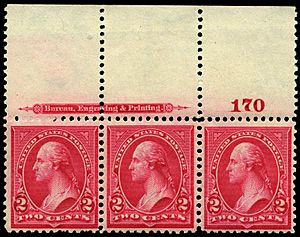Plate block facts for kids

A plate block is a special group of postage stamps. It includes not just the stamps themselves, but also a part of the paper edge, called the margin. This margin has a unique serial number printed on it. This number tells you which printing plate was used to make those stamps. Think of it like a batch number for stamps!
Sometimes, these plate numbers are printed directly on the stamps. But usually, you'll find the number on the margin of the stamp sheet. Often, the name of the company that printed the stamps is also there.
Contents
What is a Plate Block?
When stamps are made, they are printed in large sheets using big metal plates. Each plate has a special number. This number helps the printers keep track of their work. A plate block is a small section cut from one of these large sheets. It always includes at least four stamps and the part of the margin with the plate number.
Imagine you have a big sheet of stickers. A plate block is like taking a few stickers from the corner, along with the blank edge that shows a special code for that sheet.
Why Collect Them?
Many people enjoy collecting plate blocks because they are unique. Regular stamps are common, but a plate block shows more about how the stamp was made. It's like having a piece of history from the printing press!
- Rarity: Plate blocks are often rarer than single stamps. Not every stamp from a sheet ends up in a plate block.
- Historical Value: They show details about the printing process. This can include the plate number, the printer's name, and sometimes even small marks that tell you more about the stamp's journey from design to your collection.
- Completeness: For serious collectors, having a plate block can make their collection feel more complete. It's not just about the stamp's design, but also its story.
- Different Numbers: Sometimes, a stamp is printed using several colors. Each color might use a different printing plate. So, a plate block might have several numbers, one for each color plate used. This makes them even more interesting to collect.
How Stamps Are Printed
Stamps are printed using large, flat metal plates. Each plate has the design of the stamp carved or etched onto it. When ink is applied to the plate, the design picks up the ink. Then, paper is pressed against the plate, transferring the ink and creating the stamps.
The plate number is like a special ID for that specific printing plate. It helps the printing company keep track of which plate was used for which batch of stamps. If there's a mistake or a change, they can easily find the right plate.
Looking at Plate Blocks
When you look at a plate block, you'll see the stamps, of course. But also look closely at the margin, the blank paper around the stamps. That's where you'll find the plate number. It might be a single number or a series of numbers. You might also see the printer's name or other small codes.
Plate blocks are usually kept together as a block. This is because their value comes from having the stamps connected to the margin with the number. Cutting them apart would make them less special.
Related pages
Images for kids



